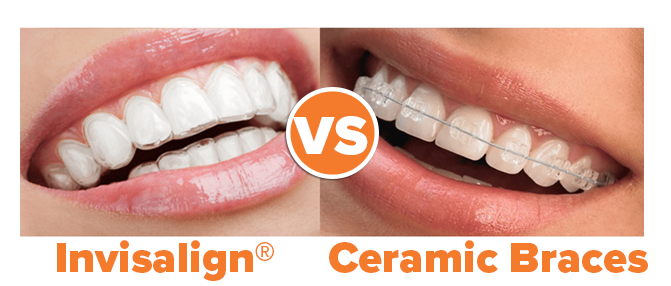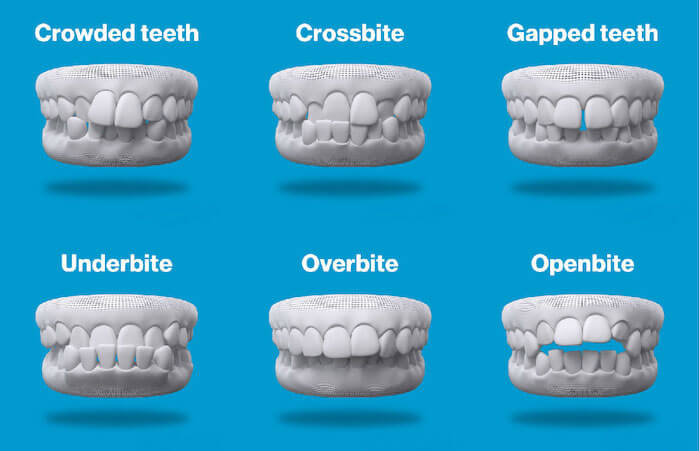Invisalign vs. Traditional Braces: Which Option Is Right for You?
When considering orthodontic treatment, the option between Invisalign and standard braces offers several crucial variables that warrant careful evaluation. Invisalign provides a discreet option with detachable aligners, while typical dental braces give a more visible yet effective service for severe misalignment. Each option incorporates distinct benefits and drawbacks related to aesthetics, comfort, treatment period, and expense. Recognizing these nuances is important for making a notified decision that lines up with your personal preferences and lifestyle. The question remains: which alternative will finest satisfy your orthodontic requirements and expectations?
Overview of Treatment Options

On the other hand, conventional dental braces contain steel brackets and cables that are bonded to the teeth. This approach applies constant stress over time to accomplish placement. While effective for intricate orthodontic issues, standard dental braces call for regular brows through for changes and can position difficulties in keeping dental hygiene due to the trouble of cleaning around cords and brackets.
Both options have their benefits, and the selection often depends upon particular dental conditions, way of life choices, and person compliance. Ultimately, seeking advice from an orthodontic specialist is critical for identifying the most appropriate therapy strategy tailored to private requirements. Comprehending the nuances of each choice can dramatically affect the total success of orthodontic treatment.
Visual Considerations
A considerable aspect influencing the option between Invisalign and conventional braces is the visual allure each therapy uses. Invisalign aligners are crafted from clear plastic, making them basically undetectable when used. This discreet look is particularly interesting teens and adults who might really feel uneasy regarding their orthodontic treatment. The ability to keep an all-natural smile throughout the positioning process can significantly enhance the patient's self-confidence in professional and social setups.
In comparison, conventional dental braces contain steel brackets and wires, which can be extra visible. While advancements in orthodontic innovation have caused the development of smaller sized braces and tinted elastics, conventional dental braces still preserve an even more conspicuous account. For some individuals, the presence of braces might deter them from seeking necessary treatment.
Inevitably, the option in between Invisalign and traditional dental braces might rest on personal choices concerning appearances. Clients that focus on discretion typically lean towards Invisalign, while those who are much less worried about exposure might go with conventional braces. Recognizing the aesthetic ramifications of each alternative is crucial for making a notified choice that straightens with one's lifestyle and choices.
Convenience and Convenience

In regards to comfort, Invisalign aligners are removable, enabling people to appreciate their preferred foods without restriction and keep optimum oral health. Cleaning and flossing are simplified, as the aligners can be obtained throughout these routines, whereas typical dental braces require mindful steering around cables and brackets.
In addition, Invisalign's modern system enables less orthodontic check outs. Clients usually receive numerous sets of aligners at as soon as, which can enhance the treatment procedure and decrease time invested in the orthodontist's chair. On the other hand, typical braces demand regular changes, making them less hassle-free for those with busy timetables. Invisalign. Generally, the comfort and comfort of Invisalign make it an appealing selection for many people looking for orthodontic treatment.
Treatment Duration and Performance
While both Invisalign and conventional braces are efficient in correcting oral imbalances, the period of therapy can differ considerably in between both alternatives. Normally, Invisalign treatment can take anywhere from 12 to 18 months, depending upon the complexity of the instance. The clear aligners work by gradually changing teeth right into their desired positions, and routine follow-ups with go to these guys an orthodontist aid make certain progress stays on course.
In contrast, typical dental braces typically need a longer dedication, normally ranging from 18 months to 3 years. This is due to their fixed nature and using cords and braces, which can be a lot more reliable for complex situations and serious imbalances (Invisalign). The treatment performance of conventional dental braces is well-documented, as they enable precise changes and greater control over tooth activity
Inevitably, the choice between Invisalign and conventional braces might depend upon both the expected treatment period and the specific oral concerns handy. Consulting with an orthodontist is vital, as they can give customized suggestions based on specific requirements, ensuring the selected method aligns with wanted results and timeframes.
Cost Comparison and Insurance Options
Expense plays a considerable function in the decision-making process for people taking into consideration orthodontic treatment, whether choosing Invisalign or traditional dental braces. On average, the price of Invisalign ranges from $3,000 to $8,000, while conventional braces typically set you back between $2,000 and $6,000. Aspects affecting these costs consist of the complexity of the situation, try this site the period of treatment, and geographical area.
Insurance insurance coverage can significantly influence out-of-pocket expenses. Many dental insurance coverage strategies supply partial coverage for orthodontic therapies, yet the specifics can vary extensively. It is important for clients to examine their insurance coverage to determine the degree of coverage for either alternative. Normally, standard braces might be much more frequently covered by insurance policy strategies contrasted to Invisalign, which some insurance providers classify as a cosmetic procedure.
Additionally, a number of orthodontic methods use adaptable payment plans, making both treatment options more available. Individuals must ask about possible financing alternatives and price cuts for in advance settlements. Evaluating the total cost, including insurance benefits and layaway plan, is pop over to this site crucial for making an educated choice that straightens with both visual preferences and budget plan considerations.

Final Thought
In summary, the choice between Invisalign and traditional braces depends upon numerous variables, consisting of visual choices, convenience, treatment duration, and price. Invisalign supplies a very discreet, detachable alternative that facilitates dental health and dietary flexibility, while traditional dental braces might be much more suitable for complex dental concerns and usually come with a lower rate factor. Eventually, examination with an orthodontist is important to analyze specific situations and determine one of the most proper treatment alternative for accomplishing optimal oral positioning.
When considering orthodontic therapy, the option in between Invisalign and standard braces provides several vital aspects that merit mindful assessment.Contrasting Invisalign and standard dental braces exposes distinct treatment alternatives for orthodontic modification.While both Invisalign and conventional dental braces are reliable in dealing with oral imbalances, the duration of therapy can differ considerably in between the 2 alternatives.Price plays a significant role in the decision-making process for people considering orthodontic treatment, whether deciding for Invisalign or traditional braces.In recap, the choice in between Invisalign and traditional dental braces hinges on several variables, including visual choices, convenience, therapy duration, and expense.